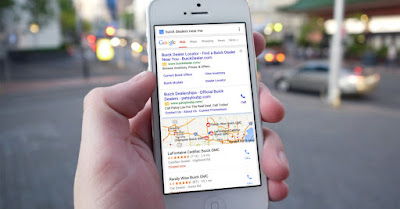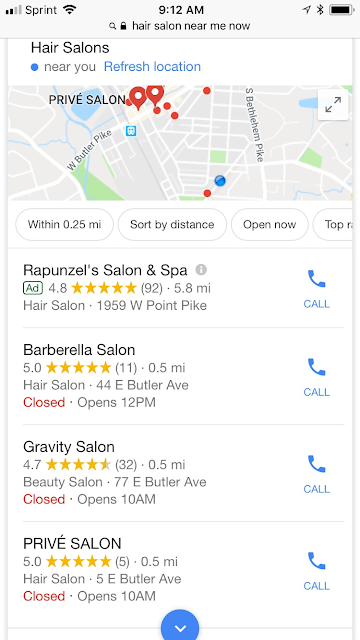How to Optimize Mobile SEO for Local Searches: 3 Tips
In the last few years, the search phrase "near me" has assumed a special significance for mobile SEO. Lisa Gevelber, Google's VP of Marketing for the Americas, has noted that the popularity of "near me" searches has intensified even as mobile users have dropped identifiers like zip codes or place names.
If you're looking for an SEO company that understands how to effectively promote websites for specific local areas we suggest contacting our sponsor, Stepman's SEO: 215-900-9398.
Stepman's SEO combines traditional marketing methods and organic SEO--with an emphasis on natural website optimization--to design thoughtful, inspiring, and effective local SEO campaigns.
"Why?" she asks, rhetorically. Mobile users, she says, "assume the results will be automatically relevant to their location," and that the results will help them "get what they need."
This "purchase intent," as Google calls it, has been highlighted more recently by another phrase:
"If you want a crystal clear example of purchase intent," Gevelber says, "near me mobile searches that contain a variant of 'can I buy' or 'to buy' have grown over 500% over the last two years."
The defining characteristic of these searches is an emphasis on the now of the search. Gevelber cites some astonishing numbers to prove the point: a "900%+ growth in mobile searches for 'near me today/tonight' and a "200%+ growth in mobile searches for 'Open' + 'now' + 'near me.'
Read: "How ‘Near Me’ helps us find what we need, not just where to go"
This information presents a challenge to local business owners: How do you offer local consumers quick answers?
Implicit in this challenge, of course, is a specific marketing challenge: How do you optimize local search for mobile devices to attract consumers who want to buy now?
"The opportunity," Gevelber notes, "is capturing their consideration--and the sale."
How to Optimize Mobile SEO for Local Searches: 3 Tips
Claim (and Optimize) Your Google My Business Account
The physical location of a searcher is the primary determinant in organic local search listing, so local business must, first, guarantee inclusion in local results. The best way to do this is to claim (and optimize) your Google My Business account.
Savvy local business owners know Google offers this free business listing--even to businesses without websites. Yet many business owners, even savvy owners, may not know that Google uses information from your Google My Business account for local organic search results--specifically, for the local "3-pack," as seen in the image below.
In the image above, you'll note three organic results just below the paid result. SEOs call this the "local 3-pack." The organic results, as noted above, are drawn from Google My Business accounts (which include user reviews), so in essence your Google My Business account is the single best form of free local advertising.
The paid result above, incidentally, is nowhere "near me," so I'd be unlikely to visit the salon. In other words, local ads don't always work.
The upshot? For local mobile SEO, it is crucial that you fill out your Google My Business listing with a unique description. And make sure you add a good profile image and cover photo, additional photos of your service and/or product, and accurate phone numbers and a business address.
Focus on Hyper-Specific Keywords
For some time now, SEOs have claimed that "long-tail keywords" are the best choice for website optimization. Opposed to "short-tail keywords," long tail keywords, which include short phrases or even sentences, specifically match the queries of today's browsers, who understand how to use longer queries to extract precise information from search engines.
However, as Search Engine Land notes, "People don’t make long-tail search queries nearly as often on mobile, so if you’re optimizing for mobile search, it doesn’t make sense to prioritize long-tail keywords."
For local businesses, this means optimizing for location-specific short-tail keywords. Two years ago, around this same time (Labor Day weekend), after Google implemented changes to local search, webmasters were seeing varying results for similar--but minutely different--keywords. Before the changes, you might've seen similar results for...“Philadelphia Chiropractor” or “Chiropractor Philadelphia” or “Chiropractor Philadelphia, PA.”
"Since the update," Search Engine Land noted, "we are seeing a lot more fluctuation between similar keywords. In some cases, I’ve looked at a listing that was filtered for one query but then appeared back in the local results if you added the state abbreviation to the keyword."
The upshot? Now is the time to perform updated keyword research for location-specific keywords. Search local short- and long-tail keywords by search volume, difficulty index, and competition. Then optimize for a variety of hyper-specific keywords suitable to your local audience--using these keywords on your website and on your Google My Business account.
Write Local Content
Many websites write big picture content pieces that speak to their specific business niche. Few websites write localized content that speaks to the community.
Of the hair salons above, for example, all offer location-specific keywords in their content, but none write location-specific content. Instead, each offers generic content about hair styling.
Search Engine Land has a helpful write-up on writing local content to rock the rankings. Beyond the specific, technical advice in that post, however, we suggest thinking more broadly about the sort of content that might appeal to your unique customers.
To write "local content," any of these salons could include content that pertains to local events or news stories: How hard water effects hair. Or even more localized content that speaks about the happenings at the salon: How one stylist grows her own vegetables to support her beauty goals.
Local SEO with Stepman's SEOThis "purchase intent," as Google calls it, has been highlighted more recently by another phrase:
"If you want a crystal clear example of purchase intent," Gevelber says, "near me mobile searches that contain a variant of 'can I buy' or 'to buy' have grown over 500% over the last two years."
The defining characteristic of these searches is an emphasis on the now of the search. Gevelber cites some astonishing numbers to prove the point: a "900%+ growth in mobile searches for 'near me today/tonight' and a "200%+ growth in mobile searches for 'Open' + 'now' + 'near me.'
Read: "How ‘Near Me’ helps us find what we need, not just where to go"
This information presents a challenge to local business owners: How do you offer local consumers quick answers?
Implicit in this challenge, of course, is a specific marketing challenge: How do you optimize local search for mobile devices to attract consumers who want to buy now?
"The opportunity," Gevelber notes, "is capturing their consideration--and the sale."
 |
| "Near me" searches can effect any industry, small to large--even the automobile industry |
How to Optimize Mobile SEO for Local Searches: 3 Tips
Claim (and Optimize) Your Google My Business Account
The physical location of a searcher is the primary determinant in organic local search listing, so local business must, first, guarantee inclusion in local results. The best way to do this is to claim (and optimize) your Google My Business account.
Savvy local business owners know Google offers this free business listing--even to businesses without websites. Yet many business owners, even savvy owners, may not know that Google uses information from your Google My Business account for local organic search results--specifically, for the local "3-pack," as seen in the image below.
 |
| Search results for a local "three-pack" for "hair salons near me now" |
The paid result above, incidentally, is nowhere "near me," so I'd be unlikely to visit the salon. In other words, local ads don't always work.
The upshot? For local mobile SEO, it is crucial that you fill out your Google My Business listing with a unique description. And make sure you add a good profile image and cover photo, additional photos of your service and/or product, and accurate phone numbers and a business address.
Focus on Hyper-Specific Keywords
For some time now, SEOs have claimed that "long-tail keywords" are the best choice for website optimization. Opposed to "short-tail keywords," long tail keywords, which include short phrases or even sentences, specifically match the queries of today's browsers, who understand how to use longer queries to extract precise information from search engines.
However, as Search Engine Land notes, "People don’t make long-tail search queries nearly as often on mobile, so if you’re optimizing for mobile search, it doesn’t make sense to prioritize long-tail keywords."
For local businesses, this means optimizing for location-specific short-tail keywords. Two years ago, around this same time (Labor Day weekend), after Google implemented changes to local search, webmasters were seeing varying results for similar--but minutely different--keywords. Before the changes, you might've seen similar results for...“Philadelphia Chiropractor” or “Chiropractor Philadelphia” or “Chiropractor Philadelphia, PA.”
"Since the update," Search Engine Land noted, "we are seeing a lot more fluctuation between similar keywords. In some cases, I’ve looked at a listing that was filtered for one query but then appeared back in the local results if you added the state abbreviation to the keyword."
The upshot? Now is the time to perform updated keyword research for location-specific keywords. Search local short- and long-tail keywords by search volume, difficulty index, and competition. Then optimize for a variety of hyper-specific keywords suitable to your local audience--using these keywords on your website and on your Google My Business account.
Write Local Content
Many websites write big picture content pieces that speak to their specific business niche. Few websites write localized content that speaks to the community.
Of the hair salons above, for example, all offer location-specific keywords in their content, but none write location-specific content. Instead, each offers generic content about hair styling.
Search Engine Land has a helpful write-up on writing local content to rock the rankings. Beyond the specific, technical advice in that post, however, we suggest thinking more broadly about the sort of content that might appeal to your unique customers.
To write "local content," any of these salons could include content that pertains to local events or news stories: How hard water effects hair. Or even more localized content that speaks about the happenings at the salon: How one stylist grows her own vegetables to support her beauty goals.
If you're looking for an SEO company that understands how to effectively promote websites for specific local areas we suggest contacting our sponsor, Stepman's SEO: 215-900-9398.
Stepman's SEO combines traditional marketing methods and organic SEO--with an emphasis on natural website optimization--to design thoughtful, inspiring, and effective local SEO campaigns.
How to Optimize Mobile SEO for Local Searches: 3 Tips
 Reviewed by penulis
on
12.56
Rating:
Reviewed by penulis
on
12.56
Rating:
 Reviewed by penulis
on
12.56
Rating:
Reviewed by penulis
on
12.56
Rating:

Post a Comment